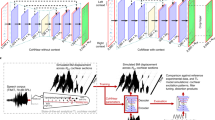Abstract
Cochlear neuroprostheses strive to restore the sensation of hearing to patients with a profound sensorineural deafness. They exhibit a stimulation of the surviving auditory nerve neurons by electrical currents delivered through electrodes placed on or within the cochlea. The present article describes a new method for an efficient derivation of the required information from the incoming speech signal necessary for the implant stimulation. Also some realization aspects of the new approach are addressed. In the new strategy, a multilayer neural network is employed in the formant frequency estimation having some suitable speech signal descriptors as particular input signals. The proposed method allows us a fast formant frequency estimation necessary for the implant stimulation. With the developed strategy, the prosthesis can be adjusted to the environment which the patient is supposed to live in. Moreover, the neural network concept offers us an alternative for dealing with the areas of neural loss or “holes” in the frequency map of the patient's ear.
Similar content being viewed by others
References
Agnew WF, McGreery DB (1990) Neural prostheses. Fundamental studies. Prentice Hall, Englewood Cliffs
Brookhart JM, Mountcastle VB (eds) (1984) Handbook of physiology. American Physiological Society, Maryland
Clark GM, Blarney PJ, Brown AM, Gusby PA, Dowell RC, Franz BK-H, Pyman BC, Shepherd RK, Tong YC, Webb RL (1987) The University of Melbourne-nucleus multi-electrode cochlear implant. Karger, Basel
Evans EF (1985) How to provide speech through an implant device. Dimensions of the problem: an overview. In: Schindler RA, Merzenich MM (eds) Cochlear implants. Raven Press, New York
Flanagan J (1972) Speech analysis, synthesis and perception. 2nd Edn. Springer, Berlin Heidelberg New York
Funahashi K-I (1989) On the approximate realization of continuous mappings by neural networks. Neural Networks 2:183–192
Girosi F, Poggio T (1990) Networks and the best approximation property. Biol Cybern 63:169–176
Hornik K, Stinchcombe M, White H (1989) Multilayer feedforward networks are universal approximators. Neural Networks 2:359–266
Kandel ER, Schwartz JH (eds) (1985) Principles of neural science. 2nd Edn. Elsevier, New York
Kirkpatrick S, Gelatt CD, Vecchi JR, Vecchi MP (1983) Optimization by simulated annealing. Science 220:671–680
Kreinovich VY (1991) Arbitrary nonlinearity is sufficient to represent all functions by neural network: a theorem. Neural Networks 4:381–383
Le Roux J, Gueguen C (1977) A fixed-point computation of partial correlation coefficients. IEEE Trans ASSP 25:257–259
Makhoul J (1975) Linear prediction: a tutorial review. Proc IEEE 63:561–580
Morris LR, Barszczewski P (1988) Design and evolution of a powerful pocket-size DSP speech processing system for a cochlear implant and other hearing prosthesis applications. Conf Proc ICASSP, 88:2516–2519
Morris LR, Barszczewski P (1989) Algorithms, hardware, and software for a digital signal processor microcomputer-based speech processor in a multielectrode cochlear implant system. IEEE Trans Biom Eng 36:573–583
Morris LR, Barszczewski P, Bosloy J (1987) Algorithm selection and software time/space optimization for a DSP micro-based speech processor for a multi-electrode cochlear implant. Conf Proc ICASSP, 87:972–975
O'Shaughnessy D (1987) Speech communication. Human and machine. Addison-Wesley, Reading
Reddy NS, Swamy MNS (1984) High-resolution formant extraction from linear prediction phase spectra. IEEE Trans ASSP 32:1136–1144
Rumelhart DE, Hinton GE, Williams RJ (1986) Learning internal representations by error propagation. In: Rumelhart DE, McClelland JL (eds) Parallel distributed processing: explorations in the microstructure of cognition, vol 1: Foundations. MIT Press, Cambridge, pp 318–362
Schafer RW, Rabiner LR (1975) Digital representation of speech signal. Proc IEEE 63:663–677
Wilson BS, Finley CHC, Lawson DT, Wolford RD (1988) Speech rocessors for cochlear protheses. Proc IEEE 76:1143–1154
Zadák J (1991) Cochlear neuroprostheses: an introduction. Slaboproud Obz 52:182–186
Zadák J, Unbehauen R (1992) A fixed point implementation of mapping neural networks on a digital signal processor. Submitted to IEEE Trans Neural Networks
Author information
Authors and Affiliations
Rights and permissions
About this article
Cite this article
Zadák, J., Unbehauen, R. An application of mapping neural networks and a digital signal processor for cochlear neuroprostheses. Biol. Cybern. 68, 545–552 (1993). https://doi.org/10.1007/BF00200814
Received:
Accepted:
Issue Date:
DOI: https://doi.org/10.1007/BF00200814




